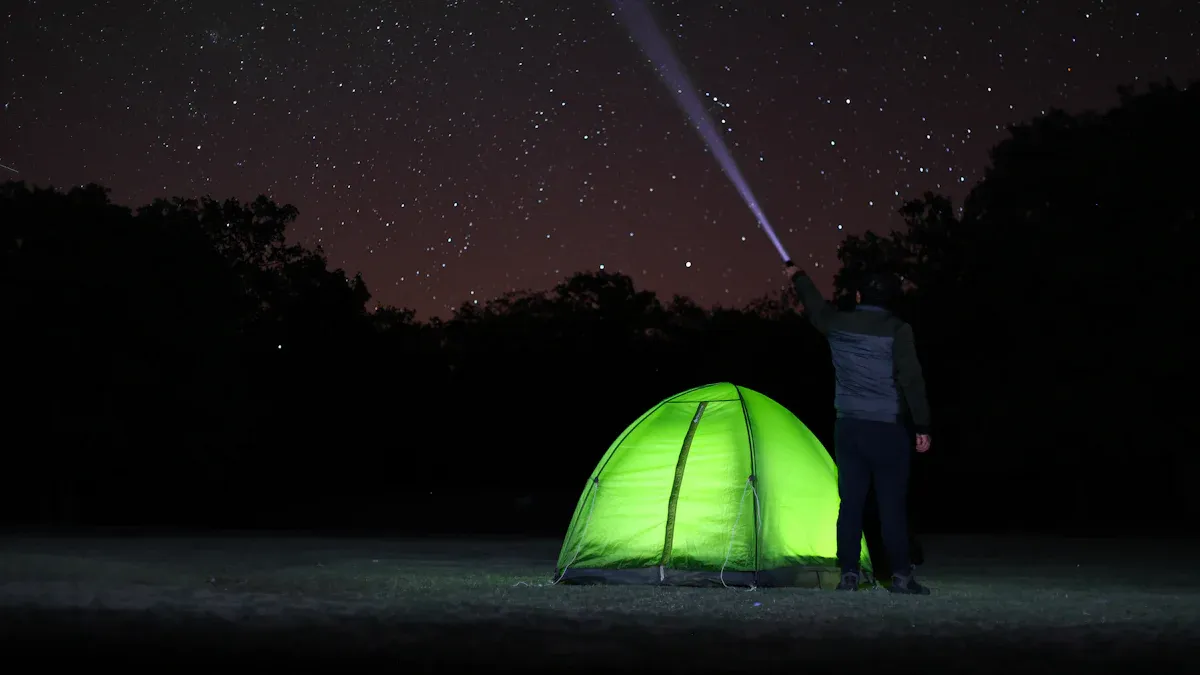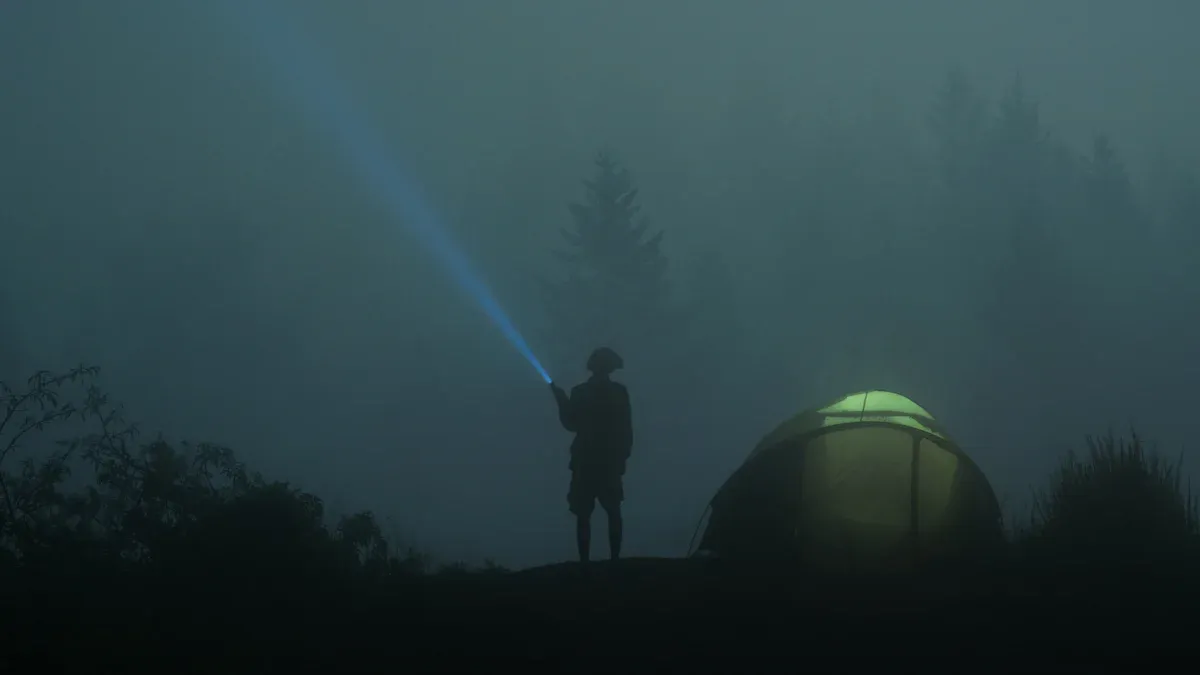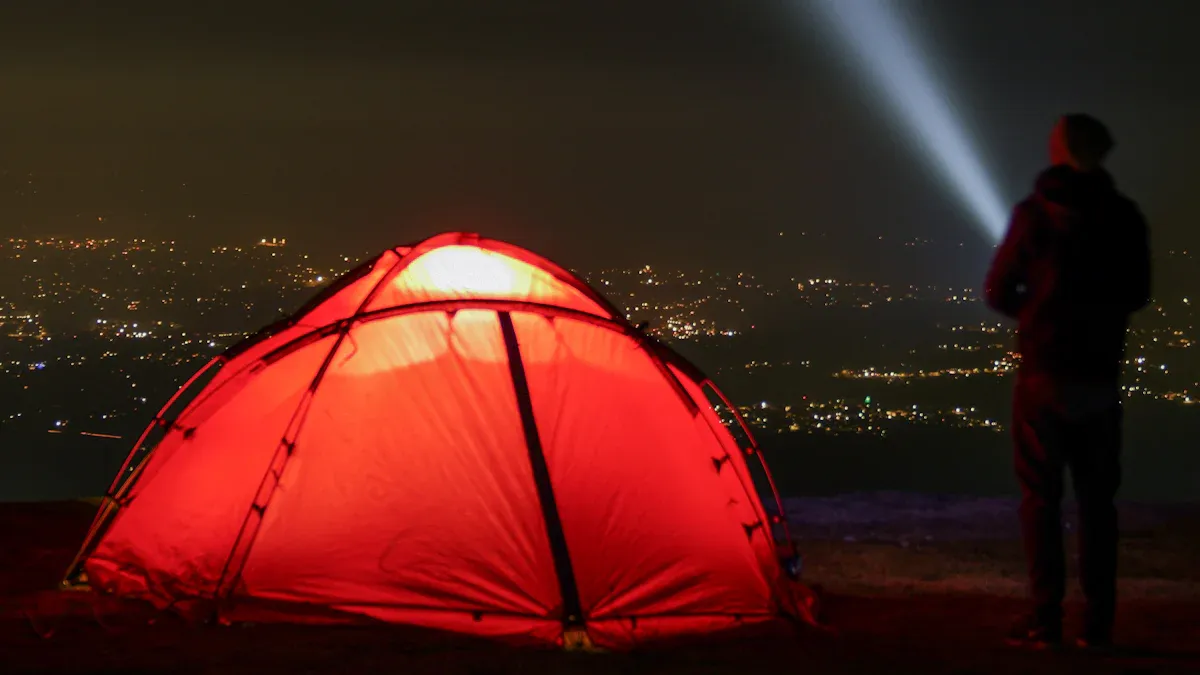How Flashlights Can Help You Avoid Accidents During Outdoor Activities

Flashlights are essential for personal safety during outdoor activities. Proper lighting helps you see clearly, avoid accidents, and stay safe in darkness. Whether you're hiking, camping, or exploring, a reliable flashlight like the helius flashlight ensures you stay aware of your surroundings and reduces risks. Emergency situations also become manageable with effective lighting.
Key Takeaways
Flashlights help you see better in the dark, keeping you safe outdoors.
A flashlight helps you spot dangers like rough ground or animals, lowering the chance of getting hurt.
Pick a good flashlight with adjustable light and lasting batteries for emergencies.
The Role of Flashlights in Outdoor Safety

Enhancing Visibility in Low-Light Conditions
Proper lighting is crucial for outdoor safety, especially in low-light conditions. Flashlights provide a focused and adjustable beam of light, making them a reliable source of light for nighttime activities. Unlike other lighting tools, flashlights allow you to illuminate specific areas, helping you navigate trails and avoid obstacles. Whether you're hiking through dense forests or setting up camp after sunset, a flashlight ensures you can see clearly and reduces the risk of accidents. This enhanced visibility is essential for emergency preparedness, as it allows you to react quickly to unexpected situations.
Avoiding Hazards Like Uneven Terrain and Wildlife
Flashlights play a vital role in detecting potential hazards during outdoor activities. They illuminate uneven terrain, helping you avoid tripping over rocks, roots, or other hidden obstacles. This is particularly important in low-visibility areas where natural light is insufficient. A flashlight also helps you spot wildlife from a safe distance, giving you time to adjust your path and avoid dangerous encounters. By providing proper lighting, flashlights enhance your outdoor emergency preparedness and ensure you stay safe in challenging environments.
Emergency Signaling with Flashlights
In outdoor emergency preparedness, flashlights are indispensable for signaling for help with flashlights. Features like SOS and strobe modes make them effective tools for attracting attention. The SOS mode sends a distress signal, while the strobe mode can disorient threats or alert rescuers in low-visibility conditions. Flashing your light in a specific pattern, such as three quick flashes followed by three slower ones, mimics the universal SOS signal. These features, combined with a flashlight's durability, make it an essential tool for emergency situations.
Preventing Common Outdoor Accidents with Flashlights

Reducing Slips, Trips, and Falls
Flashlights are indispensable for reducing the risk of injury during outdoor activities. Proper lighting illuminates paths, helping you avoid tripping hazards like rocks, roots, or uneven surfaces. This is especially critical in emergencies or power outages when natural light is unavailable. By providing clear visibility, flashlights allow you to navigate safely and prevent accidents that could lead to serious injury. Whether you're hiking on rugged trails or walking through a campsite, a flashlight ensures you stay safe by highlighting potential dangers in your path.
Navigating Trails and Avoiding Getting Lost
Navigating dangerous areas becomes significantly easier with a reliable flashlight. It provides the light you need to see clearly in darkness, ensuring you can follow trails and avoid veering off course. A flashlight also helps you spot trail markers or landmarks, reducing the chances of getting lost. In emergencies, it can serve as a signaling tool to attract rescuers' attention. For instance:
It illuminates your path, helping you avoid obstacles.
It prepares you for unexpected events, ensuring safety in unforeseen circumstances.
It allows you to spot natural hazards from a distance, keeping you out of harm's way.
By using a flashlight, you enhance your emergency preparedness and gain peace of mind during outdoor adventures.
Detecting and Avoiding Dangerous Terrain
Flashlights play a vital role in navigating through dangerous areas. They illuminate unlit regions, allowing you to identify and avoid hazardous terrain. For example, you can spot slippery slopes, loose gravel, or unstable ground before stepping into danger. This proactive approach reduces the risk of injury and ensures your safety in darkness. Flashlights also help you detect wildlife or other potential threats, giving you time to adjust your route. With proper lighting, you can confidently explore outdoor environments while minimizing risks.
Choosing the Best Flashlight for Outdoor Safety
Key Features of a Reliable Flashlight (Brightness, Battery Life, Durability)
When selecting a reliable flashlight, you should focus on features that enhance its performance and durability. Brightness is a critical factor. A flashlight with adjustable lumens allows you to control the intensity of the light, making it suitable for various situations like hiking or camping. Long battery life is equally important, especially for extended outdoor trips. Look for models with replaceable batteries or rechargeable options to ensure uninterrupted lighting. Durability is another key consideration. A robust flashlight can withstand rough handling and harsh conditions, making it an essential gear for outdoor safety. Additionally, water resistance ensures the flashlight remains functional in wet environments, such as during rain or snow.
Types of Flashlights for Outdoor Activities (Helius Flashlight, Headlamps, Handheld)
Different types of flashlights cater to specific outdoor needs. Headlamps offer hands-free operation, making them ideal for activities like hiking or setting up a campsite. They provide a wider beam but are less suited for long-range visibility. Handheld flashlights, such as the helius flashlight, deliver a more focused beam and are better for spotting distant objects. They are portable but require you to hold them, which may limit multitasking. The helius flashlight stands out as a reliable flashlight due to its brightness, durability, and versatility. Choosing the right type depends on your activity and lighting requirements.
Feature | Headlamp | Common Flashlight |
|---|---|---|
Hands-Free Operation | Yes | No |
Beam Focus | Wider, less focused | More focused, adjustable |
Portability | Very Portable | Portable but requires holding |
Weight | Lightweight | Varies, often heavier |
Long-Range Visibility | Less suited | Better for long-range |
Weather-Resistant and Waterproof Flashlights
Weather-resistant and waterproof flashlights are essential gear for outdoor adventures. These flashlights perform reliably in all weather conditions, including rain, snow, and fog. Their enhanced durability makes them suitable for rugged use, such as hiking or camping in challenging terrains. Waterproof models also provide safety in darkness during emergency situations like storms or floods. They ensure consistent lighting, helping you stay safe and prepared. Investing in a weather-resistant flashlight ensures you can confidently tackle outdoor challenges without worrying about equipment failure.
Practical Tips for Using Flashlights Effectively
Conserving Battery Life and Carrying Spares
Proper battery management ensures your flashlight remains functional during outdoor activities. To conserve battery life, use the lowest brightness setting that provides adequate lighting. Avoid using high-intensity modes unless necessary. Always carry spare batteries to prevent unexpected failures. Follow these best practices to extend battery life:
Regularly check and replace batteries to avoid sudden power loss.
Remove batteries if the flashlight will remain unused for a long time to prevent corrosion.
Store batteries in a cool, dry place to maintain their quality.
Additionally, clean the flashlight lens regularly to ensure optimal light output. Store your flashlight in a dry location to prevent moisture damage. These steps help you stay safe and prepared during emergencies.
Using Flashlight Modes for Different Situations
Modern flashlights come with multiple modes designed for specific scenarios. Understanding these modes enhances your outdoor safety. For instance, strobe mode increases visibility and can deter potential threats, while SOS mode acts as a universal distress signal. Here's a quick guide to flashlight modes and their uses:
Flashlight Mode | Use Case |
|---|---|
Spotlight Mode | Long-distance visibility, signaling for help |
Floodlight Mode | Wide-area illumination for camping or emergencies |
Strobe Mode | Attention-grabbing in low-light conditions, self-defense |
SOS Mode | Distress signal for rescuers |
Use spotlight mode for hiking or search missions, and floodlight mode for illuminating campsites. Strobe and SOS modes are invaluable in emergencies, helping you stay safe and visible.
Ensuring Your Flashlight is Always Ready
A reliable flashlight is crucial for outdoor safety. To ensure your flashlight is always ready, test it periodically to confirm functionality. Keep it in an easily accessible location for quick use during emergencies. Regular maintenance is also essential. Inspect battery contacts for corrosion and clean them as needed. Store the flashlight in a cool, dry place to protect its quality. By following these steps, you reduce the risk of accidents caused by equipment failure and enhance your preparedness for any situation.
Flashlights are indispensable for outdoor safety, offering reliable lighting to prevent accidents and ensure you stay safe. They illuminate paths, help you navigate emergencies, and reduce risks during outdoor adventures. Always keep a flashlight in your emergency kit, test it regularly, and store it properly to maintain its functionality and quality.
FAQ
What type of flashlight is best for outdoor safety?
Choose a durable, weather-resistant flashlight with adjustable brightness and long battery life. Headlamps are ideal for hands-free use, while handheld models offer focused lighting.
How can a flashlight help you stay safe in darkness?
A flashlight illuminates your path, helping you avoid hazards like uneven terrain or wildlife. It also serves as an emergency signaling tool, ensuring you remain visible in low-light conditions.
Why is it important to carry spare batteries for your flashlight?
Spare batteries ensure your flashlight remains functional during emergencies. They prevent unexpected power loss, allowing you to maintain lighting and avoid accidents in critical situations.
See Also
Why Hunting Flashlights Are Crucial for Outdoor Lovers
SF1 Camping Flashlight: Brighten Up Your Outdoor Experiences
Camping Adventures: Choosing Between Lanterns and Flashlights
